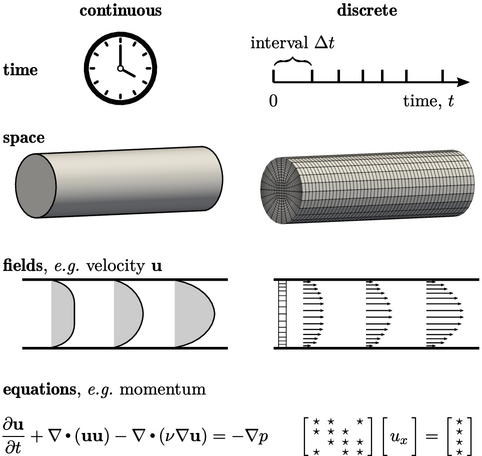Chapter 3 Numerical Method
“We were talking about the space between us all.”
The Beatles, Within You, Without You (1967).
Chapter 2 described:
- the main governing equations of fluid dynamics, namely conservation laws of mass, momentum and energy;
- standard models for diffusion of momentum and heat, namely Newton’s law of viscosity and Fourier’s law of conduction;
- the ideal gas equation of state and specific heat capacity;
- tensor algebra used in the equations and the derivatives of time, divergence, gradient and Laplacian.
Sets of governing equations and models are combined to simulate different flow problems. Numerical methods are used in CFD to solve the equations since closed-form, analytical solutions only exist for very simple geometries and flow regimes.
The numerical methods represent continuous physical entities by equivalent discrete entities, i.e.:
- time is
split into intervals of duration
 ;
; - space becomes cells of a mesh — the solution domain;
- fields,
e.g.
 , become discrete
values, e.g. one per
cell;
, become discrete
values, e.g. one per
cell; - partial differential equations, e.g. for momentum, become a set of linear equations.
There are numerous discretisation methods to create the set of linear equations, but this book specifically examines the finite volume method.
The sets of equations can be solved using a variety of algorithms, with finite volume discretisation lending itself towards iterative methods.

3.2 Computational mesh
3.3 Finite volume mesh
3.4 Equation discretisation
3.5 Matrix construction
3.6 Overview of discretisation
3.7 Laplacian discretisation
3.8 Surface normal gradient
3.9 Advection discretisation
3.10 Upwind scheme
3.11 Limited advection schemes
3.12 Useful TVD schemes
3.13 Limiting multiple components
3.14 Linear upwind scheme
3.15 Gradient discretisation
3.16 Gradient limiting
3.17 Time discretisation
3.18 Second order time schemes
3.19 Calculated derivatives
3.20 Other terms
3.21 Terms which change sign
3.22 Bounded advection discretisation
3.23 Recommended discretisation schemes
3.24 Example of building a matrix equation

